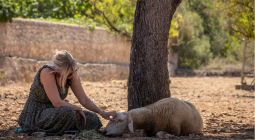Hot and alone: how US cities work to protect isolated people in heatwaves

An elderly woman protects herself from the sun in Toulon, France, on 27 July 2024. Photograph: Magali Cohen/Hans Lucas/AFP/Getty Images
The dangers of extreme heat can be amplified by social isolation, experts have warned, with those living alone found to be most likely to suffer.
“Heatwaves are deadly,” Eric Klinenberg, a sociologist at New York University who studies climate disasters, once said. “Cold societies make them far more lethal.”
Data shows people living alone were more likely to perish in Europe’s record-breakingly hot summer in 2022 and 2021’s US Pacific north-west heat dome. Klinenberg documented a similar phenomenon back in 1995 while covering a deadly heat event in Chicago, when temperatures soared to 106F (41C) over the span of five scorching days, and more than 700 people died.
During the heatwave, Black people, poor people and the elderly were most likely to die, he found – and so were people who were socially isolated, living alone and without a close social circle who could frequently check on their wellbeing.
“Hundreds died alone behind locked doors and sealed windows that entombed them in suffocating private spaces where visitors came infrequently and the air was heavy and still,” Klinenberg wrote in his book 2002 book Heat Wave: A Social Autopsy of Disaster in Chicago.
Klinenberg told the Guardian that by conducting “organized outreach” to the elderly, the isolated, the chronically ill, and those without air conditioning, they can help shield people from the worst impacts of extreme heat.
“City agencies can make phone calls, work with local community organizations, even ask community police officers, home health aides, and home meal delivery workers to knock on people’s doors and tell them how to stay safe,” he said.
Heat illness, he added, can be difficult to recognize in one’s own body, making isolation all the more dangerous.
“It’s hard to distinguish between ordinary heat and discomfort and truly dangerous conditions, like heat stress and hyperthermia,” he said. “Being alone means there is no one watching you and telling you that you look like you need help. In too many cases, that help comes too late.”
As heatwaves become more frequent due to climate breakdown, some cities are beginning to take these findings into account.
In New York City, the health department, inspired by Klinenberg’s research, in 2020 created the Be a Buddy program to strengthen social bonds and improve public health. Through the programme, community organisations in three low-income neighbourhoods gather volunteers to develop relationships with elderly neighbours, especially those who live alone, lack air conditioning and have chronic health or serious mental health conditions. When the mercury peaks, volunteers check on these residents.
Philadelphia, Pennsylvania, has a similar programme, rallying thousands of volunteers to boost social cohesion in neighbourhoods across the city. During heatwaves, the “block captains” check in on residents, especially those who are older, and provide them with information about city resources. Officials also send out heat alerts and display the number for a health hotline on a prominent, tall city building. A study found the efforts averted an average of 45 deaths per year.
In Baltimore, which saw record-breaking heat in July, agencies send out text message, email and phone call alerts to residents during “code red” heat emergencies, and take additional steps to reach those who do not have cellphones. Through its resiliency hub program, the city partners with organisations in various areas, including non-profits and faith-based groups, to provide water and cooling to those who live nearby.
“You have to bring the resources to them, to the community, where people know you and you already have that trust,” said Pastor Brenda of Allen AME church in Baltimore’s Poppleton neighborhood, which has a median income under $25,000 a year, and where many people lack cars or access to robust public transit. “It’s a lifeline for so many people … who aren’t going to go on social media or go far away.”
Kim Eshleman, who directs Baltimore’s office of emergency and preparedness, said amid extreme heat, isolation was “one of the city’s biggest challenges”. The city is working to expand cooling centres and partner with additional community groups to decrease heat risk. But in the meantime, she said ordinary residents can help.
“Make sure to check on your neighbours and loved ones,” she said.
These interventions can be life-saving, but experts say systemic change is also required to boost social cohesion and heat resilience. Disinvestment in neighbourhoods and the degradation of public space have made people more likely to isolate and stay inside, Klinenberg has argued.
“In recent decades, we’ve neglected to invest in publicly accessible gathering places, such as parks and libraries, and in poor neighborhoods they are in low supply,” he said. “We can’t really protect cities from extreme heat unless we take better care of urban neighborhoods, particularly the ones where poor and old people are concentrated.
“The US, unfortunately, has refused to address either urban poverty or climate change with the urgency they deserve. That’s why so many people here face such dire risks as the planet warms.”





